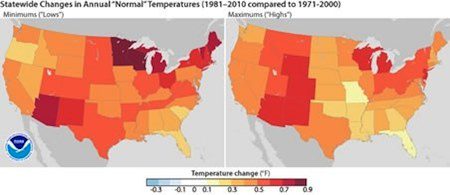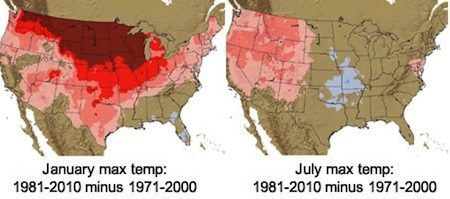
Tomorrow the National Oceanic and Atmospheric Administration (NOAA) will incorporate new baseline data reflecting new climate “normals” for 1981-2010. For the past decade baseline normals spanned the period from 1971-2000.
These normals “serve as a 30 year baseline average of important climate variables that are used to understand average climate conditions at any location and serve as a consistent point of reference,” said the NOAA in a press release this week. Based on updated data encompassing the past decade (and leaving the 70’s behind), temperatures in the US are, on average, 0.5 degrees Fahrenheit warmer in the new baseline normal than the previous.
That’s to be expected given the warming of the past decade, says National Climatic Data Center director Thomas Karl: “The climate of the 2000s is about 1.5 degree F warmer than the 1970s, so we would expect the updated 30-year normals to be warmer.”
In every state the annual average maximum and minimum temperature has increased within the contiguous US, according to NOAA data. Warming has increased in all seasons, but winter months have seen much more rapid increase in temperatures than summer months (see image below).
 State of the Climate 2010
State of the Climate 2010
Earlier this week NOAA released it’s annual State of the Climate Report for 2010. The report is compiled by nearly 370 scientists from 45 nations and shows 2010 as one of the two warmest years on record. Not all of the extreme weather events of 2010 are indicators of the larger climactic trend, but as a summary report from NOAA explains:
“In the background of many unique events, long-term trends are visible in the data; despite snow and cold in some locations, tens of thousands of observations around the world combine to reveal a 2010 average global surface temperature among the two warmest years on record.”
Among the climate indicators noted in the report:
- Arctic Oscillation – the Arctic Oscillation is an atmospheric climate pattern the typically confines colder air to northern latitudes. When the pattern flips, frigid air flows out of the Arctic, contributing to more severe winters farther south and warmer conditions in Arctic regions.
- Snow and ice – decrease in snow cover of the Northern Hemisphere between December 2009 and May 2010 was the largest in more than 40 years. Globally, mountain glaciers lost mass for then 20th consecutive year. Greenland lost more ice than in any previous year on record. Arctic sea ice shrank to its third smallest area on record. In September, ice extent was so small that for the first time in modern history, the Northwest Passage and Northern Sea Route were both open to navigation. Conversely, due to by air circulation patterns, Antarctic sea ice grew to record levels during the Southern winter.
- Sea level – Sea levels across the globe continue to rise, on average, due to thermal expansion and melting glaciers and ice sheets.
- Air temperature – Air temperature above land was the second warmest on record. The Arctic warmed at about twice the rate of lower latitudes.
- Oceans
- Sea surface temperature: despite a cooling in the eastern tropics of the Pacific Ocean of 2 degrees F due to transitioning from El Niño to La Niña, global average sea surface temperatures were the third highest on record.
- Ocean heat content: 2010 was on par with 2009 and was among the “highest values on record,” according to the report. Oceans store much of the heat trapped by increasing greenhouse gases.
- Greenhouse gases – Carbon dioxide levels in the atmosphere increased at a rate greater than the average over the past 30 years.
Additional sources and further reading:
Washington Post
NOAA State of the Climate 2010 Highlights (pdf)
Related articles
- State of the 2010 Climate Puts it at One of Warmest Ever (planetsave.com)
- NOAA Makes It Official: 2011 Among Most Extreme Weather Years in History (scientificamerican.com)
- Rapid Arctic Climate Change Could Intensify Sea Level Rise, Analysis Warns (globalwarmingisreal.com)
- NOAA State of the Climate in 2010 (bespacific.com)
Image credits: NOAA




Very eye opening! Thanks for sharing this with us all!